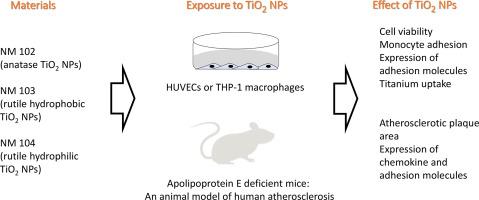当前位置:
X-MOL 学术
›
NanoImpact
›
论文详情
Our official English website, www.x-mol.net, welcomes your
feedback! (Note: you will need to create a separate account there.)
Effects of physiochemical characteristic of nano-sized TiO2 on the adhesion of monocytes to endothelial cells
NanoImpact ( IF 4.7 ) Pub Date : 2020-10-01 , DOI: 10.1016/j.impact.2020.100257 Yuka Suzuki , Gaku Ichihara , Satoshi Kawada , Kunichi Miyazawa , Tomoki Furutani , Arisa Hayashida , Eri Watanabe , Cui Zong , Lang Tran , Akihiko Ikegami , Sahoko Ichihara
NanoImpact ( IF 4.7 ) Pub Date : 2020-10-01 , DOI: 10.1016/j.impact.2020.100257 Yuka Suzuki , Gaku Ichihara , Satoshi Kawada , Kunichi Miyazawa , Tomoki Furutani , Arisa Hayashida , Eri Watanabe , Cui Zong , Lang Tran , Akihiko Ikegami , Sahoko Ichihara

|
Abstract Nano-sized titanium dioxide (TiO2) particles are produced on a large scale and are widely used. However, the effects of exposure to nano-sized TiO2 particles on the cardiovascular system remain elusive. The present study investigated how the crystal structure and surface characteristics of nano-sized TiO2 particles affect the adhesion of monocytes to endothelial cells, which is an essential process in atherosclerogenesis. Human umbilical vein endothelial cells (HUVECs) and human monocytic leukemia cells (THP-1) were exposed to anatase (NM102), rutile hydrophobic (NM103), and rutile hydrophilic (NM104) TiO2 nanoparticles. Incubation of HUVECs with NM102, NM103, or NM104 at 100 μg/ml significantly reduced cell viability, and cell viability was also significantly reduced after exposure to 75 μg/ml of the anatase particles (NM102). Brief exposure to NM102 and NM103 increased the level of intercellular adhesion molecule-1 (ICAM-1) in HUVECs. Exposure to NM102 also upregulated the expression of lymphocyte function-associated antigen-1 (LFA-1) in THP-1 cells, resulting in enhanced adhesion of these cells to HUVECs. The amount of titanium uptake of NM102 in cells was higher than that of NM103 or NM104, as evidenced by inductively coupled plasma optical emission spectroscopy (ICP-OES). To examine the effects of long-term exposure to nano-sized TiO2 on the process of atherosclerosis, apolipoprotein E deficient (ApoE−/−) mice were exposed to TiO2 NPs (NM102, NM103, or NM104 at 10 or 40 μg/mouse) by pharyngeal aspiration once every other week for 10 weeks. As the results, NM102 (40 μg/mouse) increased plaque formation in the aorta, and this increase correlated with a significant upregulation of ICAM-1 and F4/80 expression in the aorta. Anatase, but not rutile, TiO2 nanoparticles promoted the adhesion of monocytes to endothelial cells, and enhanced atherosclerogenesis in a susceptible animal model.
中文翻译:

纳米二氧化钛理化特性对单核细胞与内皮细胞粘附的影响
摘要 纳米二氧化钛(TiO2)颗粒大规模生产并得到广泛应用。然而,暴露于纳米级二氧化钛颗粒对心血管系统的影响仍然难以捉摸。本研究调查了纳米二氧化钛颗粒的晶体结构和表面特征如何影响单核细胞与内皮细胞的粘附,这是动脉粥样硬化形成的一个重要过程。人脐静脉内皮细胞 (HUVEC) 和人单核细胞白血病细胞 (THP-1) 暴露于锐钛矿 (NM102)、金红石疏水 (NM103) 和金红石亲水 (NM104) TiO2 纳米颗粒。HUVEC 与 NM102、NM103 或 NM104 以 100 μg/ml 孵育显着降低细胞活力,并且在暴露于 75 μg/ml 锐钛矿颗粒 (NM102) 后,细胞活力也显着降低。短暂接触 NM102 和 NM103 会增加 HUVEC 中细胞间粘附分子-1 (ICAM-1) 的水平。暴露于 NM102 还上调 THP-1 细胞中淋巴细胞功能相关抗原 1 (LFA-1) 的表达,导致这些细胞对 HUVEC 的粘附增强。NM102 在细胞中的钛摄取量高于 NM103 或 NM104,如电感耦合等离子体发射光谱 (ICP-OES) 所证明的那样。为了检查长期暴露于纳米级 TiO2 对动脉粥样硬化过程的影响,载脂蛋白 E 缺陷(ApoE-/-)小鼠暴露于 TiO2 NPs(NM102、NM103 或 NM104,浓度为 10 或 40 μg/小鼠)通过咽部抽吸每隔一周一次,持续 10 周。结果,NM102(40 μg/小鼠)增加了主动脉中的斑块形成,这种增加与主动脉中 ICAM-1 和 F4/80 表达的显着上调相关。锐钛矿,但不是金红石,TiO2 纳米颗粒促进单核细胞与内皮细胞的粘附,并增强易感动物模型中的动脉粥样硬化。
更新日期:2020-10-01
中文翻译:

纳米二氧化钛理化特性对单核细胞与内皮细胞粘附的影响
摘要 纳米二氧化钛(TiO2)颗粒大规模生产并得到广泛应用。然而,暴露于纳米级二氧化钛颗粒对心血管系统的影响仍然难以捉摸。本研究调查了纳米二氧化钛颗粒的晶体结构和表面特征如何影响单核细胞与内皮细胞的粘附,这是动脉粥样硬化形成的一个重要过程。人脐静脉内皮细胞 (HUVEC) 和人单核细胞白血病细胞 (THP-1) 暴露于锐钛矿 (NM102)、金红石疏水 (NM103) 和金红石亲水 (NM104) TiO2 纳米颗粒。HUVEC 与 NM102、NM103 或 NM104 以 100 μg/ml 孵育显着降低细胞活力,并且在暴露于 75 μg/ml 锐钛矿颗粒 (NM102) 后,细胞活力也显着降低。短暂接触 NM102 和 NM103 会增加 HUVEC 中细胞间粘附分子-1 (ICAM-1) 的水平。暴露于 NM102 还上调 THP-1 细胞中淋巴细胞功能相关抗原 1 (LFA-1) 的表达,导致这些细胞对 HUVEC 的粘附增强。NM102 在细胞中的钛摄取量高于 NM103 或 NM104,如电感耦合等离子体发射光谱 (ICP-OES) 所证明的那样。为了检查长期暴露于纳米级 TiO2 对动脉粥样硬化过程的影响,载脂蛋白 E 缺陷(ApoE-/-)小鼠暴露于 TiO2 NPs(NM102、NM103 或 NM104,浓度为 10 或 40 μg/小鼠)通过咽部抽吸每隔一周一次,持续 10 周。结果,NM102(40 μg/小鼠)增加了主动脉中的斑块形成,这种增加与主动脉中 ICAM-1 和 F4/80 表达的显着上调相关。锐钛矿,但不是金红石,TiO2 纳米颗粒促进单核细胞与内皮细胞的粘附,并增强易感动物模型中的动脉粥样硬化。











































 京公网安备 11010802027423号
京公网安备 11010802027423号